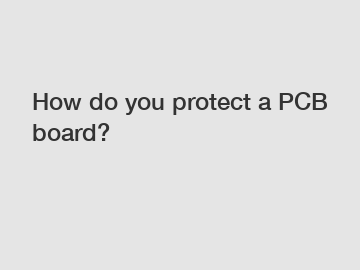Dec. 29, 2023
Electronic Components & Supplies
How do you protect a PCB board?
Printed Circuit Boards (PCBs) are an essential part of electronic devices, powering everything from smartphones to industrial machinery. Their delicate design and susceptibility to damage make it crucial to protect them from environmental factors, physical harm, and electrical interference. In this article, we will explore different methods and techniques for safeguarding PCB boards.
Environmental Protection.

One of the primary threats to PCB boards is moisture and humidity. Excessive moisture can cause corrosion, short circuits, and lead to the failure of critical components. To protect PCBs from environmental factors, conformal coatings are often used. These thin polymeric films provide a protective layer that safeguards against moisture, dust, and chemical contaminants. Conformal coatings such as acrylics, urethanes, and silicones offer different properties like flexibility, hardness, and dielectric strength to suit various applications.
Another method for environmental protection is encapsulation. This involves covering the entire PCB with a protective material, usually an epoxy resin or silicone. Encapsulation provides excellent resistance against moisture, physical damage, and even helps dissipate heat generated during operation. This technique is commonly used in demanding environments like aerospace and automotive industries.
Physical Protection.
PCB boards are susceptible to physical damage from rough handling, shock, and vibration. Therefore, mechanical protection becomes crucial, especially for applications in harsh environments. Mounting options such as surface mount technology (SMT) or through-hole technology (THT) assist in securing the PCB to the chassis or enclosure. Additionally, components like corner brackets, standoffs, and spacers can be used to enhance stability.
Using vibration-damping materials, such as silicone gels or foam pads, helps absorb shocks and vibrations that can damage components. These materials act as buffers, reducing stress and extending the lifespan of the PCB.
Electromagnetic Interference (EMI) Protection.
Electronic devices are increasingly vulnerable to electromagnetic interference, which can disrupt their proper functioning. Shielding is an effective method to safeguard PCB boards from EMI. EMI shielding can be accomplished through metal enclosures, conductive coatings, or shielding gaskets made from materials like copper, aluminum, or nickel. These shielding elements create a barrier that prevents electromagnetic waves from affecting the PCB.
Grounding techniques are also crucial to minimize electrical noise and interference. A solid grounding system ensures that unwanted electrical currents do not flow through sensitive traces, reducing the risk of component failure.
Closing paragraph:
In conclusion, protecting PCB boards from environmental factors, physical harm, and electrical interference is vital to ensure their optimum performance and lifespan. By implementing appropriate techniques such as conformal coatings, encapsulation, mechanical protection, shielding, and grounding, PCBs can be safeguarded from various threats. If you require assistance or further information regarding PCB protection, feel free to contact us. Our expert team is always ready to assist you and provide the best solutions tailored to your specific needs.
Keywords: contact us.
If you want to learn more, please visit our website Lead Free HASL PCB , Lead Free HASL PCB , security product pcb board .
If you are interested in sending in a Guest Blogger Submission,welcome to write for us!
All Comments ( 0 )